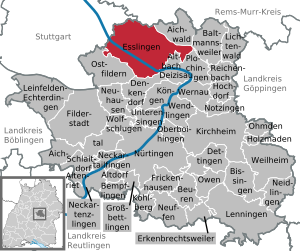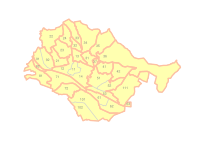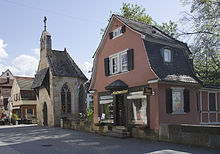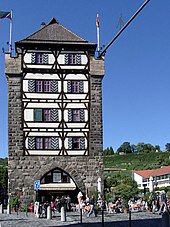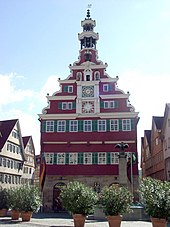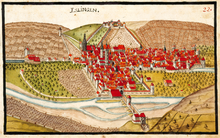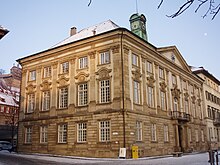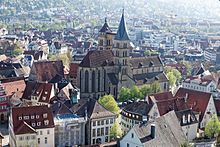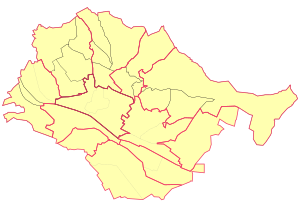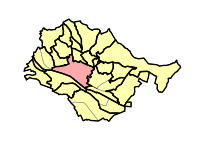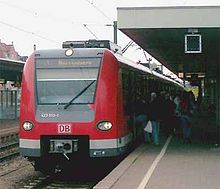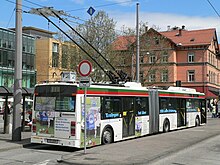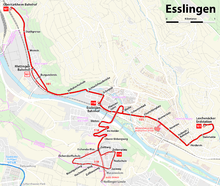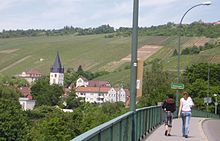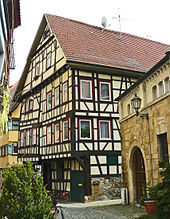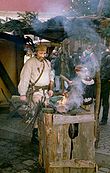Esslingen am Neckar
| coat of arms | Germany map | |
|---|---|---|

|
Coordinates: 48 ° 44 ' N , 9 ° 19' E |
|
| Basic data | ||
| State : | Baden-Württemberg | |
| Administrative region : | Stuttgart | |
| County : | Esslingen | |
| Height : | 241 m above sea level NHN | |
| Area : | 46.42 km 2 | |
| Residents: | 93,542 (Dec. 31, 2018) | |
| Population density : | 2015 inhabitants per km 2 | |
| Postcodes : | 73728-73734 | |
| Area code : | 0711 | |
| License plate : | ES, NT | |
| Community key : | 08 1 16 019 | |
| City structure: | Core city and 23 districts | |
City administration address : |
Rathausplatz 2 73728 Esslingen am Neckar |
|
| Website : | ||
| Lord Mayor : | Jürgen Zieger ( SPD ) | |
| Location of the city of Esslingen am Neckar in the Esslingen district | ||
Esslingen am Neckar ([ ˈɛslɪŋən ], Swabian: Esslenga [ ˈeslẽŋɐ ]), officially until October 16, 1964 Eßlingen am Neckar , about ten kilometers southeast of the city center of Stuttgart and in the middle of the region of the same name , is a large district town and at the same time the largest medium-sized town of Baden -Wuerttemberg and its tenth largest city. It is the seat of the district office and also the largest city in the Esslingen district . Esslingen forms a middle center for the surrounding communities . The inhabitants have the nickname Zwieblinger. The city administration sees Esslingen as an “engineering city” and aligns its building policy accordingly.
First mentioned in a document in the 8th century, Esslingen was a free imperial city since 1181 . In 1803 the city lost its independence and was incorporated into the Duchy of Württemberg . Industrialization in the 19th century led to an economic boom and shaped the image of the city.
The Baden-Württemberg section of the German Half-timbered Road runs through the city.
geography
Geographical location
Esslingen am Neckar is located at a narrow point in the Neckar Valley, southeast of Stuttgart. The river crosses the urban area from southeast to northwest, with the old town to the north of it. The Esslingen barrage is also located here . Coming from the municipality of Altbach , the Neckar first touches the district of Zell and leaves the urban area between the districts of Mettingen and Weil in the direction of Stuttgart. Esslingen am Neckar extends in the east to the height of the Schurwald , in the south the foothills extend to the Filder plain .
The city extends over an altitude of 230 meters in the Neckar Valley to 498 meters in the Schurwald.
Land use
Esslingen has an area of 4643 hectares . Of this, 1,193 hectares consist of forest and 112 hectares of water. Vines belonging to the Württemberg wine-growing region are grown on 93 hectares . 1662 hectares are built-up land on which the approximately 90,000 inhabitants live, with roads, squares, paths and railways.
Neighboring communities
The following cities and municipalities border the city of Esslingen am Neckar, they are named clockwise starting in the north: Kernen im Remstal ( Rems-Murr-Kreis ), Aichwald , Baltmannsweiler , Plochingen , Altbach , Deizisau , Denkendorf and Ostfildern (all districts of Esslingen ) as well as Stuttgart (city district).
City structure
The city consists of the following 24 districts:
Berkheim , Brühl , Hegensberg , Hohenkreuz , city center, Kennenburg , Kimmichsweiler / Oberhof , Krummenacker , Liebersbronn , Mettingen , Neckarhalde , Oberesslingen , Obertal , Pliensauvorstadt , Rüdern , Serach , Sankt Bernhardt , Sirnau , Sulzgries , Wäldenbronn , Weil , Wiflingshausen , Zell , Zollberghausen .
Esslingen also includes the exclave Stadtwald Esslingen am Neckar Stiftswald in the city of Stuttgart ( 48 ° 44 ′ 41.24 ″ N , 9 ° 3 ′ 41.69 ″ E ).
Spatial planning
Esslingen is a medium-sized center within the Stuttgart region , the regional center of which is the city of Stuttgart. The towns and communities in the north of the district also belong to the central area of Esslingen: Aichwald , Altbach , Baltmannsweiler , Deizisau , Denkendorf , Hochdorf , Lichtenwald , Neuhausen auf den Fildern , Ostfildern , Plochingen , Reichenbach an der Fils and Wernau .
Division of space

According to data from the State Statistical Office , as of 2014.
history



Early history
Archaeological finds prove that there has been permanent settlement in what is now the city of Esslingen since the Neolithic Age . Traces of human settlement from around 1000 BC have been found under today's town church. Documented. A Viereckschanze is known from the La Tène period near Esslingen .
Roman times
In the first century AD, the Esslingen area became part of the Roman Empire after the Romans had crossed the Rhine around 70 AD. During this time a Roman manor was built in the area of Oberesslingen and a Roman villa in Berkheim. The next larger settlements were Cannstatt and Köngen ( Grinario ).
Migration period and Merovingian period
From post-Roman times in the Neckar Valley around Esslingen there are no early Halemannic finds that are definitely present on the Fildern. Some finds come from Rüdern that indicate a rich grave with eastern influences, such as a set of three-winged arrowheads. The ending " -ingen " of the place name indicates a group of people for which a man named Azzilo, Hezzilo or Hetsilo played a formative role as landlord or head of the family. so that the name means "among the people of Azzilo". This name, first documented as Ezelinga and 866 AD as Hetsilinga , was finally preserved in its current form.
In the 6th century, the Alamanni were subjugated by the Merovingians under King Clovis I. However, the Alemanni took on administrative tasks even under Franconian rule and formed a duchy in the Franconian Empire. In the 8th century they tried to restore an independent rule. The attempt failed in 746 near Cannstatt. The end of the Alemannic duchy was marked with the subsequent blood court in Cannstatt .
In an archaeological excavation that is significant in terms of research history, Günter Fehring was able to excavate the remains of the Vitalis cella under the church of St. Dionysius. Evidence of settlements in the area around the Cella goes back to the late Merovingian period. The row grave fields in Oberesslingen and Sirnau are older .
Esslingen's documented confirmation and advancement
The first written mention of Esslingen comes from the year 777. Abbot Fulrad von Saint-Denis bequeathed the cella above the Neckar, which he had previously received from an Alemannic nobleman by the name of Hafti , together with the remains of the martyr Vitalis in the event of his death the Merovingian imperial monastery of Saint-Denis near Paris . After the abbot's death (784), the monastery had the remains of Vitalis transferred from Italy to the cella . Then the place developed into a heavily visited place of pilgrimage . Esslingen was first mentioned by name as Hetsilinga in a document from Ludwig the German from 866, in which the market rights of the place with the Vitalis-Cella are confirmed. The market rights were probably granted around the year 800 in order to secure the income of the monastery and the supplies of the pilgrims. The favorable location of the place on an old trunk road from Flanders to Northern Italy, which crossed the Neckar near Esslingen, was beneficial for the establishment of a market and the pilgrimage.
Esslingen was a mint from around 950 to 1050 . Few records exist from this period. It is believed that Esslingen was already a well-developed place when Rudolf von Rheinfelden held a Princely Congress in Esslingen in 1077. In the same year Heinrich IV went to the field against the rival king Rudolf, which resulted in a battle near Esslingen. Was the site previously believed belonged to the Dukes of Swabia, he probably came in 1079, together with the duke of Swabia and the castle Hohenstaufen of Frederick I and the Staufer .
The Hohenstaufen in power
Frederick I Barbarossa transferred in 1181 his deputy in Esslingen political and legal tasks related to the surrounding area, and made Esslingen at the latest in order to Reichsland city .
On December 30, 1213, King Friedrich II gave the Esslingen city church St. Dionys with the nursing courtyard opposite to the cathedral chapter of Speyer . A Staufer stele in front of the former Latin school in Abt-Fulrad-Straße 3 has been commemorating this event since 2016. In the 13th century, the construction of many large buildings in Esslingen began. Monasteries were built, the bridge over the Neckar dates from this time and the St. Vitalis Church was expanded. In 1229, the Esslingen city charter and the office of mayor were first mentioned in a donation to the Salem monastery .
Several Hohenstaufen rulers held court in Esslingen, including Heinrich (VII.) And Conrad IV. Rudolf von Habsburg awarded the city a city constitution in 1284, in which the patriciate and the guilds of the city were given co-administration.
With the wealth, the mendicant orders came to the city in the 13th century . They preached poverty and penance and cared about the salvation of the city's population. The Dominicans , Franciscans and Carmelites soon received significant donations and bequests with which they built monasteries and churches in the city.
Dispute with Württemberg
In 1246 Esslingen fought in contrast to Count Ulrich I of Württemberg in the Battle of Frankfurt on the side of the Hohenstaufen. This began a centuries-long dispute with the Württemberg people , which also came to fruition in the Imperial War of Henry VII against Eberhard I, when Stuttgart, along with other cities in Württemberg , had to submit to the Reich and the city of Esslingen in 1312 before the peace treaty of 1316 restored the Württemberg cities released from Esslingen rule. In 1356, Charles IV took advantage of the ongoing dispute when, as a result of a guild dispute, he had the city of Esslingen besieged by Eberhard the Greiner . In the late 14th century, further hostilities broke out between the Swabian cities and the Württemberg people, which only subsided after the Battle of Döffingen in 1388.
From 1448 to 1454, customs disputes with Count Ulrich V of Württemberg led to the great city war, which was won by the Württemberg people. Esslingen then initially concluded an alliance with Baden , but in 1473 a treaty with the Counts of Württemberg that exempted the people of Esslingen from taxes on their properties in the county . The contract renewed in 1477 lasted until the imperial immediacy was lost.
As early as 1472/73, shortly after the death of Johannes Gutenberg , Konrad Feyner opened Esslingen's first printing shop in Esslingen.
In 1488 the Reichstag was held in Esslingen, on which, among other things, the Swabian Federation was founded. The last fighting between Esslingen and Württemberg took place in 1519. In the course of the disputes that the Württemberg Duke Ulrich waged against various cities, however, he was chased out of the country by the Swabian Federation, so that Württemberg temporarily came under Austrian administration until 1534.
reformation
Evangelical preaching began in the city in 1522. The first Protestant pastor was employed here in 1526. Since 1527, a community of Reformation Anabaptists was formed , against which six death sentences were taken in 1529. From 1531 the free sermon was allowed and the reformer Ambrosius Blarer was hired, in 1532 Jakob Otter became pastor on his recommendation . In the same year the interior of the churches was destroyed in an iconoclasm .
In 1531 Esslingen joined the Schmalkaldic Union of Protestants. When the subsequent war against Charles V was lost, the reading of the Holy Mass had to be reintroduced from 1548 as a result of the Augsburg interim . In 1551 Protestant services were held again in Esslingen. Mayor Matthias II. Herwart von Bittenfeld (1510–1584) signed the Lutheran formula of 1577 for the council of Esslingen in 1579 .
Thirty Years' War
During the Thirty Years' War from 1618 to 1648, the city suffered greatly. After the Battle of Nördlingen in 1634, around 12,000 refugees poured into the city, and the plague broke out in the following year. Around half of the population died from hunger and epidemics . Financially, the city was bled out at the end of the war, but retained its independence in the Peace of Westphalia .
War of the Palatinate and Spanish Succession
The next conflict followed as early as 1688 with the War of the Palatinate Succession . The city was occupied by the French General Mélac in 1688 , followed by General Mazel's troops in 1693. In 1701 a fire ravaged around 200 houses in the city, including the town hall. As a result, the entire burned down city district was rebuilt in the Baroque style. In 1707, Esslingen was reoccupied by the troops of General Villars during the War of the Spanish Succession .
The 18th century also marked the remarkable rise of the Esslingen family of Palm . The family managed to rise from the Esslingen bourgeoisie to the imperial prince class within three generations, but died out a little later. Johann David Palm (1657–1721) was a financial specialist at the imperial court in Vienna and acquired a huge fortune as the owner of one of the leading Austrian private banks. In 1687 he was raised to the Hungarian nobility and in 1711 to the imperial knighthood . His son, Carl Joseph of Palm (1698-1770) was an imperial diplomat and became in 1729 the Empire baron and in 1750 the imperial counts . Carl Joseph Graf von Palm (1749–1814), a grandson of Johann David Palm, bought the Hohengundelfingen estate including the castle in 1774 and in 1783 he was raised to the rank of imperial prince . With his son, Prince Carl Joseph von Palm (1773-1851), the sex ended. Another branch of the family had the Oberer Palmschen Bau built in Esslingen , today's New Town Hall . Construction began in 1747 and was completed in the 1760s. In 1840 the building was made into the town hall.
Esslingen loses its independence
When, after the French Revolution, the German territories on the left bank of the Rhine fell to France, the territories and clerical principalities that were free from the empire were dissolved and distributed to the countries that had lost their territories on the left bank of the Rhine. Even before the Reichsdeputationshauptschluss of 1803, the Württemberg government councilor Wächter with the Württemberg military appeared in Esslingen on September 6, 1802 to take possession of the city for Württemberg. On November 23 of the same year, the civilian occupation followed. Integrated into the Württemberg administration, the city became the seat of the Oberamt Esslingen , to which, in addition to the city, the branch villages Deizisau, Möhringen and Vaihingen were subordinate. After the establishment of the Kingdom of Württemberg there were a few changes until 1810 before the final structure of the Oberamt was established. The places Möhringen and Vaihingen, for example, came to the Stuttgart Oberamt in 1807 .
industrialization
At the beginning of the 19th century there was only one metal goods factory and one winch factory in Esslingen. Then, however, a strong industrialization set in , as a result of which Esslingen took the first place in the Württemberg cities in terms of the number of workers and the size of the company in the 1830s. The oldest factories belonged predominantly to the textile and leather industry , including a cloth factory and a glove factory. The food industry followed soon after, with the Kessler sparkling wine cellar founded in 1826, and the metal industry . In 1842 there were around 1,500 workers in 18 factories.
When railway construction began in Württemberg, Esslingen was the terminus of the first construction project, the Zentralbahn Ludwigsburg – Stuttgart – Esslingen. The first train of the Württemberg State Railways reached Esslingen (from Cannstatt ) on November 20, 1845. The Esslingen branch of the Zentralbahn was expanded a little later in the direction of Ulm , with the first section Esslingen– Plochingen inaugurated on December 14, 1846. The expansion of the railway by the Kingdom of Württemberg led to the establishment of the Esslingen machine factory . Until around 1860, the metal industry took the leading place in Esslingen. In addition to the metal goods factory, several machine and tool factories were created.
The emerging industrial areas shaped the image of the city. After a large part of the city walls and gates as well as the old Katharinenhospital had already been torn down between 1805 and 1811, another wave of demolitions began in 1838, in which the old Holy Cross Chapel, the nave of the rear church and the old Pliensa mills disappeared and instead factories , a telegraph station, a gas station and so on. In 1865, as industrialization continued, the Pliensauvorstadt was built on the left bank of the Neckar . In 1894 the first employment office in Germany was built in Esslingen.
In the middle of the 19th century, industrialization changed the relationship between employer and employee . The differences grew stronger and in 1848, during the March Revolution in the states of the German Confederation , August Hochberger founded the first workers' association in Esslingen. This first association initially only existed for four years, but was then re-founded in 1862 as a workers' education association and with 250 members was soon the second largest of these associations in Württemberg. Hochstetter also founded a consumer association in 1865. In 1869 the first trade union association of textile workers in Württemberg was founded in Esslingen . The city became a stronghold of the Württemberg labor movement until the First World War .
Weimar Republic and National Socialism
On November 9, 1918, there were demonstrations by workers. A workers 'and soldiers' council was elected. In 1919 communist workers took over the city. A military operation by the Stuttgart government cost 16 lives and forced a return to calm.
A local branch of the NSDAP was formed in Esslingen as early as 1922 . In 1933, the local council of Esslingen was dissolved by the National Socialists in the course of the Gleichschaltung. In 1935, Esslingen am Neckar was declared a "city district" due to the German municipal code. In the course of the administrative reform during the Nazi era in Württemberg , the previous Oberamt Esslingen was transferred to the Esslingen district in 1938 and enlarged by some areas. Above all, some communities on the Fildern (previously Amtsoberamt Stuttgart ) and in Schurwald (previously Oberamt Schorndorf ) came to the district area.
The Esslingen synagogue in Heppächer was desecrated during the Reichspogromnacht . Surviving Jews were deported to the east for extermination. The "Israelitische Orphans- und Erziehungsanstalt Wilhelmspflege" was demolished in 1939 and converted into an epidemic hospital. The last Jewish home manager, Theodor Rothschild , was murdered in 1944 in the Theresienstadt concentration camp . Stumbling blocks are now reminiscent of some of the victims of the National Socialists in Esslingen .
During the Second World War , 60 houses in Esslingen were completely destroyed and 75 were seriously damaged, 260 moderately and 1236 were slightly damaged. The loss of housing due to air strikes was 2.1%, 74 people were killed.
On April 22, 1945, Esslingen was occupied by US soldiers.
Post-war period - Esslingen is growing
After 1945, Esslingen belonged to the American zone of occupation and thus came to the state of Württemberg-Baden , which was added to the state of Baden-Württemberg in 1952. According to the new municipal code, the city was declared an "immediate district town".
By 1947, around 47,000 people (mostly refugees and displaced persons from eastern Germany) had moved to the city. Settlements in Oberesslingen, on the Zollberg (1955), in the Lerchenäckern (1959), on the Hohenbühl, in the Kirchäckern and in Mettingen alleviated the housing shortage and enabled further growth of the city. A women's dormitory was set up in the city center . New industrial areas were created in Oberesslingen, Sirnau and Zell.
Since the city had more than 20,000 inhabitants since the end of the 19th century and was an "immediate district town", Esslingen am Neckar was declared a major district town by law when the Baden-Württemberg municipal code came into force on April 1, 1956 .
On June 13, 1961, the Esslingen railway accident brought the city to the center of public attention when two trains collided head-on between the Esslingen and Mettingen stations. In this accident, 35 people lost their lives.
On January 1, 1973, Esslingen am Neckar became the seat of the Esslingen district, which had been expanded to include the area of the previous district of Nürtingen . On May 1, 1974, Berkheim was incorporated into Esslingen, and on July 1, 1974, Zell am Neckar was incorporated .
In 1979 the Heimattage Baden-Württemberg took place in Esslingen . In 1995 Esslingen donated the Theodor Haecker Prize for political courage and sincerity.
At the end of March 31, 1984, the Esslingen University of Education , which was founded in 1811 as the first Württemberg "school teacher seminar", was closed due to a change in the law by the Baden-Württemberg state parliament.
The largest urban development project since the turn of the millennium is the conversion of the former freight yard and the adjoining former headquarters of the food manufacturer Hengstenberg into a residential and commercial area under the title "Neue Weststadt". The project began in 2009 with the first road construction work and an urban planning competition for the approximately ten hectare area. The total investment volume for the area was then estimated at around 400 million euros. The winning design of the planning competition envisaged nine building blocks with three to six floors, a district square, two pedestrian bridges over the tracks and the Neckar as well as a new park on the bank. So far, however, only a student dormitory and minor conversions of existing buildings have been realized.
Population development
With industrialization in the 19th century, the city's population grew very quickly. In 1803 only 7,000 people lived in the city, by 1900 there were already 27,000. Shortly after the Second World War , the large number of refugees and displaced persons from the eastern German territories led to an increase in the population of 15,000 people to 65,000 in October 1946 within one year. In 1974 the population reached 97,029 due to the incorporation of Berkheim and Zell Peak. In 2004 the proportion of foreigners in the total population was 20.5 percent (18,304 people), according to the city administration. On June 30, 2013, the “ official population ” for Esslingen was 88,584 according to the 2011 census (only main residences and after comparison with the other state offices). Esslingen is currently the eleventh largest city in Baden-Württemberg .
Incorporations
Many of today's 24 districts of Esslingen have been part of the Esslingen city area as branches since the 14th century, but some of the places had their own sub- school . Only the following places or districts were incorporated into the city in the 20th century :
- 1913: Oberesslingen and Oberhof
- 1914: Hegensberg (belonging to Oberesslingen until 1844, then an independent municipality) and Kimmichsweiler
- 1923: Brühl (from Stuttgart-Obertürkheim)
- 1929: Sirnau (acquired by the Deizisau municipality)
- 1935: Because
- May 1, 1974: Berkheim
- July 1, 1974: Zell am Neckar
Denominations

Esslingen has been predominantly evangelical since the age of the Reformation. Due to the strong influx of workers as a result of industrialization in the 19th century and of refugees and displaced persons after the Second World War, numerous Catholics again came to the city, and due to the further growth of industry in the period after the Second World War, other denominations also came.
More than 200 people from Esslingen are currently again professing their Jewish faith. The Israelite Religious Community of Württemberg is currently planning to set up a community center in the former synagogue building.
In 2008, a church in Esslingen, the Protestant Garden City Church, built in 1952, was demolished for cost reasons.
Denomination statistics
Around 2000, around 39 percent (35,100) of Esslingen's residents were Protestant and around 27 percent (24,300) were Catholic. There is also a Greek Orthodox community, Muslims and many other religious communities in the city. According to the census on May 9, 2011, 23.1% of the population were Roman Catholic, 32.8% Protestant and 44.2% belonged to other denominations or religious communities or were non-denominational.
politics
Municipal council
The municipal council in Esslingen has 40 members. The turnout in the local elections on May 26, 2019 was 54.47% (2014: 46.22%). The following distribution of seats resulted:
| Parties and constituencies | % 2019 | Seats 2019 | % 2014 | Seats 2014 | ||
|---|---|---|---|---|---|---|
| GREEN | Alliance 90 / The Greens | 24.40 | 9 | 18.65 | 7th | |
| SPD | Social Democratic Party of Germany | 21.15 | 8th | 25.06 | 10 | |
| Free voters | Free Independent Voters' Association Esslingen am Neckar e. V. | 19.54 | 8th | 20.62 | 8th | |
| CDU | Christian Democratic Union of Germany | 17.71 | 7th | 23.80 | 10 | |
| THE LEFT | The left | 6.75 | 3 | 5.34 | 2 | |
| FDP | Free Democratic Party | 6.57 | 3 | 4.06 | 2 | |
| FOR Esslingen | Individual election alliance, progressive, non-partisan regulation FOR Esslingen | 3.88 | 2 | 2.46 | 1 | |
| total | 100 | 40 | 100 | 40 | ||
| voter turnout | 54.47% | 46.22% | ||||
The municipal council consists of the elected voluntary councilors and the mayor as chairman. The mayor is entitled to vote in the municipal council.
mayor
Several mayors and the council were at the head of the imperial city of Esslingen. The number of members changed several times. From 1748 there were only two mayors. In the time of Württemberg, the mayor was called "Stadtschultheiß", since 1930 mayor, and when it was elevated to the status of a major district town on April 1, 1956, the official title was mayor . This will be directly elected by the electorate for eight years (next election 2020). He is chairman of the municipal council. Since March 1, 1998 (re-elected on October 8, 2006 and September 28, 2014) Jürgen Zieger ( SPD ) has held the office of Lord Mayor and heads the city's general administration (Department I).
Three councilors are elected by the local council as general deputies of the mayor. These are currently as First Mayor Wilfried Wallbrecht, who heads the technical area (Department II), Mayor Ingo Rust in the financial administration (Department III) and Mayor Yalcin Bayraktar for the regulatory, social, cultural and school system (Department IV).
Mayor of Esslingen since 1803
|
|
elections
Esslingen has been represented in the Bundestag as part of the Esslingen constituency since 2002 by Markus Grübel (CDU) (direct mandate) and until 2013 by Karin Roth (SPD). The latter was Parliamentary State Secretary at the Federal Minister for Transport, Building and Urban Development from 2005 to 2009. Grübel was Parliamentary State Secretary at the Federal Minister of Defense from December 2013 to March 2018 and has been the Federal Government's Commissioner for worldwide religious freedom since April 2018 .
Representatives in the state parliament of Baden-Württemberg are Andreas Deuschle (CDU), Andrea Lindlohr (Bündnis 90 / Die Grünen; direct mandate) and Nicolas Fink (SPD) since the resignation of Wolfgang Drexler (SPD) on December 31, 2018.
Citizens' Committees
The citizens' committees are a special feature of Esslingen's local politics . These are voluntary representatives of a district or a group of several districts and are elected by its citizens for a period of three years. The non- secret elections take place in the context of a citizens ' meeting, whereby the elections are held at the beginning of the event and are not part of the official citizens' meeting. The citizens' committees serve the city administration and the municipal council as contact persons for matters relating to their district.
The individual citizens 'committees are members of the working group of citizens' committees in the city of Esslingen. The voting members of the working group elect a board for a period of three years. On February 21, 1991, the working group decided to work and structure the committees in a so-called status .
An agreement was reached as a basis for cooperation between the citizens' committees, the municipal council and the administration . This was approved by the working group on July 17, 1990 and approved by the municipal council on December 10, 1990. In June 2000, both the status and the agreement were editorially revised.
Citizens' Committee districts with residents:
| district | Citizens Committee | Population as of June 30, 2009 |
|---|---|---|
| 1 | Downtown | 17,287 |
| 2 | Rüdern - Sulzgries - Krummenacker - Neckarhalde (RSKN) | 8,940 |
| 3 | Wäldenbronn - Serach - Hohenkreuz - Obertal | 8,907 |
| 4th | St. Bernhardt - Kennenburg - Wiflingshausen | 5,426 |
| 5 | Liebersbronn - Hegensberg - Kimmichsweiler / Oberhof (citizens' committee from the mountain) | 7,334 |
| 6th | Oberesslingen | 13,021 |
| 7th | Sirnau | 832 |
| 8th | Pliensauvorstadt | 5,927 |
| 9 | Zollberg | 5,083 |
| 10 | Mettingen - Weil - Brühl | 5,083 |
| 11 | Berkheim | 7,760 |
| 12 | Cell | 4.164 |
The City Center Citizens Committee has 18 members and is responsible for representing the interests of city center residents. He is committed to maintaining the quality of life. Due to the wide range of tasks, the committee has set up several working groups.
coat of arms
The coat of arms of the city of Esslingen am Neckar shows a red armored, black eagle with a breast shield split from green and red, in it the black capital letters C and E.
The heraldic animal is the imperial city eagle . The letters CE stand for Civitas Esslingensis . The seal with the coat of arms was first mentioned in 1219. The earliest surviving seal impression is from the year 1232. After initially only an eagle was depicted, the breastplate was later added to distinguish it from other imperial cities. The city flag was set in 1601. The letters in the breast shield were not added until the 17th century.
Its colors are taken from the costumes of the city militia, as they were worn since the 15th century, although these were initially green-brown. The city colors of Esslingen green and red are derived from the coat of arms.
In addition to the official seal , the eagle is used in particular on official notices, job advertisements, city flags , certificates or as a badge on uniforms (for example, the Esslingen volunteer fire brigade or the municipal enforcement service). In addition, the city's eagle and logo are used together in city print and publications. On urban business paper, the eagle is highlighted in a large format with a brightness of 10%.
City logo
The logo of the city of Esslingen am Neckar consists of a figurative mark and a word mark . The word “ Stadt Esslingen am Neckar” is an integral part of the logo as a word mark. It may only be used in this form, font and style. The figurative mark consists of a square that is halved horizontally. The upper half is green and represents the landscape. The lower half is red and symbolizes the city. In the right half there is an S-shaped blue line that protrudes above and below the square and symbolizes the Neckar.
Town twinning
Esslingen am Neckar has ten twin cities (as of March 2016):
- Eger in Heves County ( Hungary ), about 130 kilometers northeast of Budapest ; since 1991
- Molodechno ( Belarus ); since 1987
- Neath ( UK ); since 1958
- Norrköping ( Sweden ), 170 kilometers south of Stockholm ; since 1964
- Piotrków Trybunalski in the center of Poland ; since 1992
- Schiedam in the Netherlands , six kilometers west of Rotterdam ; since 1964
- Sheboygan , Wisconsin , 50 miles from Milwaukee , USA ; since 1967
- Udine / Friuli ( Italy ); since 1959
- Velenje ( Slovenia ); since 1970
- Vienne / Département Isère ( France ), 30 kilometers south of Lyon ; since 1958
In 1971 Esslingen received the flag of honor of the Council of Europe .
On January 7, 2004 Esslingen received the badge of honor from the Council of Europe for “outstanding achievements in promoting the European idea” in connection with the ten city partnerships. It was presented to Mayor Jürgen Zieger on behalf of the entire Esslingen citizenship at the New Year's reception.
Sponsorship
In 1979 the sponsorship for the expelled Germans from the city and the district of Krummau an der Moldau was taken over.
Economy and Infrastructure
The city's companies are mainly active in the services, electrical industry, vehicle construction, mechanical engineering, media and publishing and pneumatics sectors and provide around 56,000 jobs in Esslingen.
The district chambers of Esslingen and Nürtingen of the IHK Region Stuttgart merged on January 1, 2005. Since then, the district chamber with 25,000 members has taken second place within the IHK Region Stuttgart and a greater say in the plenary assembly. Another reason for the merger was cost savings.
media
Esslingen's daily newspaper is the Eßlinger Zeitung , which has been publishing the city of Esslingen's public announcements since 1973 on the basis of a municipal council resolution. The publishing and printing company Bechtle, based in the Oberesslingen district, publishes the Cannstatter Zeitung and the Untertürkheimer Zeitung in addition to the Eßlinger Zeitung . The Stuttgart edition of Bild is also produced in-house, and Bechtle also prints the entire Baden-Württemberg edition of Bild und Bild am Sonntag .
The monthly city magazine es-presso serves as an event calendar and magazine for a target group between 18 and 35 years of age.
Authorities, courts and institutions
Esslingen is the seat of the Baden-Württemberg State Office for Monument Preservation and the Esslingen District Office and thus houses most of the district's offices. The city has a tax office and a local court , which the district court - and Oberlandesgerichtsbezirk belongs Stuttgart. In Esslingen there is a state academy for advanced training and personnel development at schools, which is subordinate to the Ministry of Culture, Youth and Sport Baden-Württemberg .
The city is the seat of the Esslingen parish of the Evangelical Church in Württemberg and the Esslingen-Nürtingen deanery of the Catholic diocese Rottenburg-Stuttgart .
Well-known companies in Esslingen am Neckar
- Bechtle Graphische Betriebe und Verlagsgesellschaft mbH & Co. KG publishes the Eßlinger Zeitung, among others. This newspaper is the official newsletter of the city of Esslingen.
- The automotive group Daimler AG has a training center in the former Roser leather factory in Pliensauvorstadt . In Mettingen the company has a gray foundry in which axle parts, gear shafts, connecting rods and 8.7 million brake discs are manufactured every year. Around 1.75 million tons of raw material had been poured by mid-2003. The plant was inaugurated in 1912 by Kaiser Wilhelm II and has since been modernized again and again.
- Bauer Gear Motor is a manufacturer of frequency converters and geared motors.
- The company Eberspächer is mainly active in the field of exhaust technology, vehicle heating and glass construction and has its headquarters in Esslingen. Since the Esslingen production facility will be closed until the end of 2022 and the production of parking heaters there will be relocated to Poland, Esslingen will be left solely with the Group's headquarters with the corresponding administrative functions.
- Festo , a manufacturer primarily of products and solutions in the field of automation , has its headquarters in Esslingen.
- Gustav Wahler focuses on the temperature and exhaust gas management of internal combustion engines. It manufactures exhaust gas recirculation valves, EGR lines and thermostats. The company, founded in 1902, was based in Esslingen am Neckar. On January 1, 2014, the company was taken over by BorgWarner Esslingen GmbH .
- Hengstenberg is a food manufacturer, best known for pickled products such as pickles, vegetables and red cabbage, but also for sauerkraut and table vinegar.
- Müller Weingarten primarily develops and builds large mechanical systems for sheet metal forming. (Merged with Schuler AG in 2011 )
- The INDEX-Werke manufacture automatic lathes.
- The Kessler Sekt GmbH & Co. KG , the first German sparkling wine (established on July 1, 1826),.
- The Esslinger Verlag JF Schreiber produces high-quality picture books. The predecessor company Schreiber-Verlag , founded in 1831, was known throughout the German-speaking world for its fairy tale books.
- The Friedr. Dick GmbH & Co. KG is a manufacturer of knives , sharpening steels and other tools for cooks and butchers . The company has been based in the neighboring town of Deizisau since 1997.
traffic
air traffic
About ten kilometers southwest of the city, in the suburb of Leinfelden-Echterdingen , Stuttgart Airport is the largest airport in the state of Baden-Württemberg.
An A321 of Lufthansa was named after Esslingen. It has its home airport in Frankfurt .
Road traffic
Esslingen is located directly on the B 10 , which has four lanes from Stuttgart to Süßen ( Göppingen district ) and continues to Ulm.
The Esslingen junction is on the A 8 from Karlsruhe to Munich .
Long-distance rail transport
The city is connected to the Deutsche Bahn AG network by the Filstalbahn from Stuttgart to Ulm . In 2009, an Intercity Express was named "Esslingen am Neckar". The timetable of the local train station only shows Mon. – Fri. in the early morning an Intercity to Munich.
S-Bahn and local transport
The S1 line of the Stuttgart S-Bahn , which shuttles between Kirchheim unter Teck and Herrenberg and thus ensures the connection to Stuttgart, serves the following four stations in Esslingen: Mettingen , Esslingen (Neckar) , Oberesslingen and Zell . The Stuttgart 21 rail concept plans to shorten the S1 to the Kirchheim unter Teck – Stuttgart Schwabstrasse section in the future . There is also a regional train, regional express and interregional express line, which additionally increases the transport offer to and from Stuttgart Hbf.
Direct bus to the airport
In order to avoid the detour via Stuttgart, the END Verkehrsgesellschaft bus line 122 runs from Esslingen train station via Scharnhausen to the airport.
Former urban tram
The Eßlingen am Neckar tram was inaugurated on May 24, 1912. On July 7, 1944, it ceased operations after 32 years and was replaced by the Esslingen am Neckar trolleybus . The operating company was the Esslinger Städtische Straßenbahn (ESS), which was renamed in 1944 to the Städtischer Verkehrsbetrieb Esslingen am Neckar (SVE) on the occasion of the conversion to trolleybuses .
Former tram END
On December 18, 1926, the Esslingen – Nellingen – Denkendorf tram went into operation. It was the last tram in Germany that received an operating license before the great wave of decommissioning. Since then there has only been approval for route extensions. This tram had to overcome a five-kilometer steep stretch from the Neckar valley to the places on the eastern Filder plain. It initially transported a total of 153 million passengers from Denkendorf and then from Neuhausen to Esslingen. In 1958 the railway got two modern large capacity trains. It was shut down in February 1978.
Trolleybus and diesel bus
→ see also: Trolleybus Esslingen am Neckar
Along with Solingen and Eberswalde, Esslingen is one of the German cities in which trolleybuses still operate. The SVE currently operates three lines electrically:
- 101: Oberesslingen Lerchenäcker terminus - Esslingen ZOB - Stuttgart-Obertürkheim train station
- 113: Esslingen ZOB - Zollberg - Berkheim (partly with battery drive)
- 118: Esslingen ZOB - Zollberg (partially with battery drive)
A total of six low-floor articulated trolleybuses from the Belgian manufacturer Van Hool and four battery hybrid trolleybuses from the Polish company Solaris are available for this purpose.
Today, Esslingen's city traffic consists of 25 bus routes, an express bus route and three night bus routes operated by SVE (101, 102, 103, 105, 111, 113, 118) and its subcontractor Rexer (104, 108, 109, 110, 112, 115, 132, 138, N12, N13), from Schlienz-Tours (106, 114, 116, X20, N14) and its subsidiary GR Omnibus (119, 120, 121, 122, 130, 131) as well as from Fischle & Schlienz (140) operate.
There are also around 50 taxis.
Car sharing
Car-sharing has been available in Esslingen since 1994 .
Redesign of the station
Since 2004, in connection with the construction of the southern bypass, major renovations have been carried out in the area of the train station, with costs totaling around 7.4 million euros. The city receives funding of 4.9 million euros from the Baden-Württemberg Ministry of the Environment and Transport. By the end of 2009, Neckarstrasse had been relocated to an area of the station area that was no longer in use and extended to the tangent. This was followed by a large-scale redesign of the station forecourt, which has now been completed.
Supply and disposal
Water supply
The Stadtwerke Esslingen supply the Esslinger citizens with drinking water. About a quarter of the water comes from Lake Constance , supplied by the Lake Constance water supply . The rest comes from the Donauried and is obtained from the state water supply .
The wastewater from the Esslingen city area is fed to the Esslingen-Zell and Stuttgart-Mühlhausen sewage treatment plants .
Garbage disposal
The district's waste management company is responsible for waste disposal in Esslingen am Neckar. There are separate collections for organic waste , household waste and paper. As part of the Green Dot, packaging is collected in so-called yellow bags . Bulky waste can be picked up free of charge by handing in one of two vouchers per year, or it can be brought directly to a disposal station yourself. Electronic scrap, metal scrap and other recyclable materials can also be disposed of at the disposal stations. There are special collections of hazardous substances for hazardous waste such as fluorescent tubes, paintwork and car care products. There are also containers for used glass and clothes, and some clubs also collect used paper and clothes.
Viticulture
Viticulture in Esslingen has a long tradition. There were already vineyards in the area in 778. Esslingen exported the wine to Alsace and Bavaria as early as the Middle Ages . In 1901 the city's first cooperative was founded. In 1970, the three cooperatives Esslingen, Sulzgries and Mettingen merged into one, which today has 167 members.
Over 20 grape varieties are grown on an area of 80 hectares . Of this, about 30 hectares are on the southern terraces on the Neckar. The smallest individual vineyard in Württemberg, Esslinger Neckarhalde , only covers one hectare and is located near Mettingen. The main part of the Esslingen range is made up of around 70 percent of red wine. Up until the 2002 vintage, the imperial eagle of the city of Esslingen could be seen on the bottles for 30 years.
See also: Württemberg (wine-growing region) and Württemberg Wine Route .
Public buildings of the city of Esslingen am Neckar
education
In Esslingen, there are next to primary schools , primary / Werkrealschule (discontinued), community schools , secondary schools , high schools and special education training and advisory centers and a university: the University of Esslingen , which was created from the merger of the College of Engineering and the College of Social Work of 2006. The city is also home to the University for Church Music of the Evangelical Church in Württemberg, an institution of the Evangelical University for Church Music Tübingen . There are the following schools (as of 05_2019):
- pure elementary schools
- Eichendorff School Zollberg
- Primary school Hegensberg-Liebersbronn
- Elementary school Mettingen
- St. Bernhardt Primary School
- Sulzgries primary school
- Elementary school Zell
- Herderschule
- Katharinenschule
- Lerchenäckerschule
- Pliensau school
- Schiller School Berkheim
- Silcher school
- Orphanage school
- Free Protestant School Esslingen (fes Esslingen)
- Elementary and secondary schools
- Lerchenäckerschule (Werkrealschule expiring)
- Haupt- and Werkrealschule
- Adalbert Stifter School (to be discontinued)
- Community schools
- Seewiesenschule with elementary school
- School downtown Esslingen from grade 5
- secondary school
- Realschule am Schillerpark (expiring)
- Zollbergrealschule
- Realschule Oberesslingen
- in planning: New School Esslingen (working title)
- Free Protestant School Esslingen (fes Esslingen)
- High schools
- Georgii High School
- Mörike high school
- Schelztor High School
- Theodor-Heuss-Gymnasium Esslingen
- Private high school in Esslingen for students with ADHD
- a special education and advice center:
- Rohräckerschule Esslingen (special focus: learning, longer hospital treatment, language, mental development, physical and motor development)
There is also a state seminar for didactics and teacher training (grammar schools).
The vocational school center of the Esslingen district in Esslingen-Zell comprises three independent schools: the Friedrich-Ebert-Schule (technical school), the John-F.-Kennedy-Schule (commercial school) and the Käthe-Kollwitz-Schule (nutritional and biotechnological school ).
The Paul Lempp Foundation runs the Evangelical College for Elderly Care in Kennenburg .
Other educational institutions in the city are the Waldorf School , the adult education center and the music school .
freetime and sports
Sports facilities
One of the largest sporting facilities in Esslingen is the Eberhard Bauer Stadium in Weil. Esslingen also has an artificial ice rink, several sports halls, sports fields and tennis courts. A large collection of sports facilities (tennis, riding, athletics, football, field hockey, cycling, gliding, mini golf, forest sports path, forest playground) can be found on the Schurwaldhöhe on the northern edge of the Liebersbronn and Wiflingshausen districts (popularly "on the Jägerhaus").
Swimming is possible in the city center in Merkel's swimming pool , in the municipal Neckar outdoor pool and in the outdoor and indoor pool in Berkheim, and the Esslingen swimming club operates its own outdoor pool on the Neckar Island for its members.
There is a signposted circular tour around Esslingen for hikers and cyclists. For hikers there is the 27.4 km long Esslinger Höhenweg and for cyclists the 33.2 km long Tour de onion .
The 188 km long Hohenzollern cycle path to Lake Constance begins in Esslingen . The 410 km long Neckar Valley Cycle Path runs through Esslingen and runs along the Neckar from Villingen-Schwenningen to Mannheim .
Important clubs
The TTC Esslingen played with its table tennis men’s team in the 1981/82, 1982/83 and 1992/93 seasons in the 1st Bundesliga .
The KSV Esslingen struggling with both the women's and the men's team in the first Judo Bundesliga .
The SSV Esslingen plays with the men's team in the German Water Polo League .
In the 1990s, ESG Esslingen was four times German champion in women's ice hockey and provided several runners-up in figure skating .
The Esslingen 1890 gymnastics club played both in the indoor handball Bundesliga ( 1968/69 , 1969/70 ) and in the field handball Bundesliga ( 1970 ).
The TSV RSK Esslingen e. V. (Turn- und Sportverein Rüdern Sulzgries Krummenacker), founded in 1900, with numerous departments such as football, table tennis, athletics, skiing, chess, handball, health sports and others, is one of the largest sports clubs in Esslingen.
The TSV 1895 eV Berkheim gymnastics with his first team Gymnastics women in the 2. Bundesliga.
Culture and sights
Medieval half-timbered houses
Along with Limburg an der Lahn and Göttingen, Esslingen is a city where the oldest half-timbered houses in Germany are located and where medieval housing can be studied in a larger context. The Heugasse 3 of 1262/63 and the Webergasse 7 of 1267 are considered the oldest so far dendrochronologically dated half-timbered houses in Germany. All stages of development of the Alemannic half-timbered buildings can be verified solely by examples from Esslingen, and until a few years ago Esslingen was the only city in which Alemannic half-timbered buildings from the 13th and 14th centuries were known; since then, only individual objects have been discovered in Nuremberg (1338), Nördlingen (1367) and Geislingen an der Steige (1397). The discovery of these half-timbered treasures is bought at a high price, because when the house at Hafenmarkt 2 was demolished , unusual ancient building structures came to light. A dendrochronological examination not only revealed the year of construction 1328 for No. 2, but also showed that the entire line No. 2-10 to 1333 had been built. As a result of the demolition, the oldest preserved row of houses in Germany was broken into. The house Webergasse 8 from 1266/67 is the oldest preserved half-timbered house in Germany and could hold this record in the long run, because post houses were built up to this time . The load-bearing posts were dug into the earth and rotten at the height of the earth's surface after 30 to 50 years, so that half-timbering can no longer be expected before 1200. Only after the load-bearing posts were no longer buryed in the second half of the 13th century, but instead placed on stones or wall bases as stands, was the life of the houses extended to centuries.
In the half-timbered style according to this, characterized by two short struts at the head and / or foot of the stand, the old town hall, built shortly before 1430, is the most important and largest monument of its kind. It is obviously a transitional style that only existed between approx It was built in 1435 and could well be called the Esslingen town hall style . The town hall in Markgröningen and the old building in Geislingen (1445) show the further development with only one strut on the stand, the so-called Swabian man . This style remained unchanged in Swabia for the next 100 years.
theatre
In 1804 the first permanent stage was set up in Esslingen on Ottilienplatz in the former Aegidienkapelle, on which only simple pieces were played at first. She didn't have a permanent ensemble yet. In 1982 the new theater was opened as a replacement for the theater opened in Strohstrasse in 1864.
In addition to the playhouse in Strohstraße, there is also the studio on Blarerplatz for children's and youth theater and the Theater am Zollberg, which is mainly used for smaller studio productions. Contemporary pieces and classics, musicals and pieces for young people and children are played.
The culture of literary puppetry (especially: marionette theater) is cultivated in the LIMA theater founded by Wilhelm Preetorius . In addition, the Cabaret of the Gallows and, since 2018, the Central Theater are venues for independent theater in Esslingen.
Museums
- The city museum in the Yellow House shows the city's history from the early Middle Ages to the present day.
- The Archaeological Museum of St. Dionys under the city church is dedicated to the medieval excavations of the city
- The J. F. Schreiber Museum shows the history of the publisher and its products.
- Villa Merkel , a municipal gallery in a former entrepreneur's villa .
There is also a large number of local, club and company museums.
Archives
There are two public archives in Esslingen: the Esslingen City Archives (Georg-Christian-von-Kessler-Platz 10) and the Esslingen District Archives (in the District Office).
Memorials
- Since 1956, the Nikolauskapelle has been a memorial and memorial to the victims of the war, including the murdered concentration camp prisoners .
- Since 1982 a plaque in the Theodor-Rothschild-Haus has been commemorating the Jewish reform educator who was a victim of the Shoah .
Open Monument Day 2008
On September 14, 2008, Esslingen was the location of the nationwide opening of the Open Monument Day . Under the motto Past Uncovered - Archeology and Building Research , the thematic focus this year was on work and working techniques in archeology in the investigation and research of ancient monuments from the Stone Age to the modern age . More than 70 monuments and archaeological workplaces were opened to visitors and offered the opportunity to take part in guided tours and lectures.
Regular events
The biggest events in Esslingen are
- in the spring:
- the Esslinger Spring with the Esslinger Garden Days
- the arts and crafts market
- the Podium Festival Esslingen
- the Rock for one world - music festival as a benefit event
- in summer:
- the citizens' festival with the day of the oath on the first weekend in July
- the EZ run , a 10 km city run at the beginning of July
- the strawberry festival
- the onion festival (until 2020 then the Städtischer Sommerhock)
- the castle festival with open-air cinema and open-air concerts
- in the autumn:
- the wine festival
- the arts and crafts market
- in the winter:
- the Christmas and Medieval Market
Every year the city's cultural department organizes a series of events to illuminate a topic from different perspectives:
- 1999: The 50th anniversary of the proclamation of the Basic Law in Germany
- 2002: The loss of the Esslingen imperial immediacy 200 years ago
- 2003: 40 years of beat music
- 2004: Soccer : 50 years ago (miracle of Bern) and 30 years ago Germany became soccer world champions
Citizens' festival and day of oath
The day of the oath with the subsequent citizens' festival takes place every year on the first weekend in July. Music is made in the streets and in the squares, clubs organize demonstrations and offer food and drinks. The largest flea market in Esslingen with hundreds of mostly private stalls takes place on Saturdays .
The day of the oath was a central event in Esslingen from 1392 to 1801. In a solemn act, the rights between the municipality and the magistrate were invoked. The book of statutes, the “largest public sanctuary in the community”, was read aloud. The mayor, council and citizens vowed loyalty and obedience to one another and affirmed this with an oath. This was always associated with a large folk festival that attracted people from all over Swabia .
Esslingen Christmas and Medieval Market
In 1997 the first medieval market stalls were set up next to the New Town Hall, as a parallel to the Christmas market that has been taking place for several years. In the meantime, every year in December on the market square, the goods are advertised at numerous stalls, just like hundreds of years ago. The half-timbered houses in the area with the old and new town hall and the historic port market as a further setting give the spectacle a unique atmosphere. Old craft techniques are shown. The Esslingen Medieval Market has grown steadily in recent years and has become an attraction for tourists from Baden-Württemberg and the surrounding countries. Since the tenth anniversary of the Medieval Market in 2006, there has been a torch parade to Esslingen Castle every year at the winter solstice.
Personalities
literature
history
- Otto Wurster: Eßlinger Heimatbuch for town and surroundings . Bechtle, Esslingen 1931.
- Otto Borst : History of the city of Esslingen am Neckar. 3. Edition. Bechtle, Esslingen 1978, ISBN 3-7628-0378-1 .
- Dorothee Bayer: Esslinger Heimatbuch. Schmidt, Esslingen 1982, ISBN 3-922360-03-3 .
- R. Christlein: Weapons from the grave find of Esslingen-Rüdern during the Migration Period. In: Germania 50. 1972, pp. 259-263
- R. Koch: Catalog Esslingen II. The Merovingian finds (the grave field of Sirnau and the finds of Berkheim, Mettingen and Oberesslingen). Stuttgart 1969 (= publication of the State Office for Monument Preservation Stuttgart ; A, 14/2)
- Lutz Reichardt: Place name book of the Esslingen district. Kohlhammer, Stuttgart 1982, ISBN 3-17-007276-5 (Publications of the Commission for Historical Regional Studies Baden-Württemberg Volume 98).
- Joachim Hahn: Jewish life in Esslingen. History, sources and documentation. Esslingen studies. Series of publications Volume 14. Esslingen 1994, ISSN 0425-3086
- The machine factory in Esslingen: 1846–1965; a factory changes the city, published by Esslinger Bank, Esslingen 1991, DNB 931490227 (= Esslingen series - history, personalities, economy , volume 8).
- Jürg Arnold: The right of inheritance of the imperial city of Esslingen . Mueller & Graeff, Stuttgart 1965 (also dissertation University of Tübingen , 1964)
- Christian Ottersbach: The Esslingen Castle. (= The Historical Place , Volume 106). Kai Homilius Verlag , Berlin 2000, ISBN 3-89706-105-8 .
- Hartmut Schäfer : City-Finding. History - archeology - building research in Esslingen. Theiss, Stuttgart 2001, ISBN 3-8062-1684-3 .
- Walter Bernhardt, Hans Koepf : The care yards in Esslingen. Sigmaringen 1982
- Michaela Jansen: The transformation of market places into cities. The example of Esslingen. In: Communications of the German Society for Archeology in the Middle Ages and Modern Times 15.2004. ( PDF )
- B. Röhm: Esslingen branches: Stories, houses and residents around 1700 to after 1900. 11 volumes.
- Christine Giersberg: Esslinger Sagen und Legenden (audio book), John Media, Schwaig 2009, ISBN 978-3-942057-00-4 .
General
- Esslingen District Court. Ministry of Finance Baden-Württemberg, June 2004
- Description of the annual oath of the imperial city of Esslingen. Facsimile printing , bookstore H. Th. Schmidt Esslingen, ISBN 3-922360-02-5
- The clock on the old town hall in Esslingen. Esslinger Kulturpreis Foundation, ISBN 3-87437-471-8 .
- Once upon a time at the Pliensauturm in Esslingen am Neckar. Fanfare procession Blau-Weiß Esslingen
- Esslingen am Neckar - art historical city guide. Bechtle, Esslingen 2001, ISBN 3-7628-0564-4 .
- Esslingen am Neckar - Official city guide. Bechtle, Esslingen 2004, ISBN 3-7628-0485-0 .
- Esslingen am Neckar - photos and texts. Lichtbildnergruppe Esslingen, 2003, bookstore Stahl Esslingen
- Holger Starzmann: Esslingen - Young "Old Town" on the Neckar. Josef Fink, Lindenberg 2003, ISBN 3-89870-083-6 .
- Leisure map of the Esslingen district. F. v. Wagner & Mitterhuber, Fellbach b. Stuttgart 1984, ISBN 3-8164-1657-8 .
- Werner May: Ha, woisch no? Stories from old Esslingen. Wartberg, Gudensberg-Gleichen 2003, ISBN 3-8313-1379-2 .
- Siegfried Stötzer: Medieval half-timbered treasures and bourgeois architecture in Esslingen a. N. from the time before 1550. Self-published, Altbach 2003
- Joachim Schäfer: Coordination of Activities - Three Years of Esslingen Youth Action Group (JAK) . In: Norbert Kühne : We work with young people . Achenbach Verlag, Giessen 1975, ISBN 3-87958-126-6 , pp. 100-127
- Egon Schreitle: Schurwald, Eßlingen, Filder. Theiss, Stuttgart 1998, ISBN 3-8062-1344-5 .
- City map Esslingen. F. v. Wagner & Mitterhuber, Fellbach b. Stuttgart 1984, ISBN 3-8164-7300-8 .
- Ursula Rojnica, Wilfried Lips: Out and about in old Esslingen. Wartberg, Gudensberg-Gleichen 2000, ISBN 3-86134-695-8 .
- Rainer Lotz: Esslingen (series of archive images). Sutton, Erfurt 2007, ISBN 978-3-86680-136-3 .
- Ulrich Bauer: Complete plant in Esslingen am Neckar. In: Denkmalpflege in Baden-Württemberg , 22nd year 1993, issue 1, pp. 80–84. ( PDF; 8.6 MB )
Web links
- Official site of the city
- Tourism in Esslingen: sights
- Esslingen in the Middle Ages
- Description of the Esslinger Höhenweg around and through Esslingen with many pictures ( memento from September 13, 2010 in the Internet Archive ) in the Internet Archive
- The historic old town of Esslingen with pictures and many details
- Postmark of the Esslingen post office with postcards of the city districts
Individual evidence
- ↑ State Statistical Office Baden-Württemberg - Population by nationality and gender on December 31, 2018 (CSV file) ( help on this ).
- ^ Home: State Statistical Office Baden-Württemberg. Retrieved July 24, 2019 .
- ↑ esslingen.de
- ↑ Katzenbacher Hof ( memento from September 20, 2011 in the Internet Archive ), Stuttgarter Zeitung from September 4, 2010
- ↑ State Statistical Office, area since 1988 according to actual use for Esslingen am Neckar.
- ↑ Egon Gersbach: Ancient Middle Bronze Age settlement ceramics from Esslingen am Neckar. In: Find report Baden-Württemberg 1/1974. Pp. 226-250.
- ^ Manfred Niemeyer (ed.): German book of place names. Walter de Gruyter, Berlin / New York 2012, ISBN 978-3-11-018908-7 , p. 168.
- ^ A b G. P. Fehring, B. Scholkmann , Peter R. Anstett: The city church of St. Dionysius in Esslingen. (= Research and reports on the archeology of the Middle Ages in Baden-Württemberg; Volume 13). Stuttgart 1995, ISBN 3-8062-1040-3 .
- ↑ Stauferstele Esslingen on stauferstelen.net. Retrieved June 7, 2016.
- ↑ Joachim J. Half Can: The Reformation in Esslingen
- ^ Tilman Matthias Schröder: Jakob Otter and the Reformation in Esslingen , Württembergische Kirchengeschichte Online
- ↑ See BSLK , p. 765; see. P. 17
- ↑ Iris Holzwart-Schäfer: The building of the Katharinenhospital in the former imperial city Esslingen am Neckar . In: Urban hospital buildings in southwest Germany from the perspective of house research. Conference in Ravensburg on April 30, 2004 (Southwest German contributions to historical building research 8), Esslingen 2009, pp. 31–40.
- ↑ a b Memorials for the Victims of National Socialism. A documentation , Vol. I. Bonn 1995, ISBN 3-89331-208-0 , p. 33
- ↑ Erich Keyser: Württembergisches Städtebuch , Stuttgart 1955, p. 489.
- ^ Heinz Bardua: War damage in Baden-Württemberg 1939–1945 . Epithet to Card 7.11. In: Commission for historical regional studies in Baden-Württemberg (Hrsg.): Historical Atlas of Baden-Württemberg . Explanations. Leonberg 1975, p. 14 ( leo-bw.de [PDF; 2,3 MB ; accessed on January 26, 2018]).
- ↑ a b c Federal Statistical Office (ed.): Historical municipality directory for the Federal Republic of Germany. Name, border and key number changes in municipalities, counties and administrative districts from May 27, 1970 to December 31, 1982 . W. Kohlhammer, Stuttgart / Mainz 1983, ISBN 3-17-003263-1 , p. 460 .
- ^ Neue Weststadt: A window into the future In: Immobilien Zeitung February 11, 2010. Accessed on September 29, 2015.
- ↑ New city quarter instead of tracks In: Immobilien Zeitung March 17, 2011. Accessed on September 29, 2015.
- ^ Return of Jewish life to Esslingen . Reported to haGalil.com on February 4, 2012.
- ^ Population in a regional comparison by religion -in% - City of Esslingen , accessed on October 4, 2019
- ^ Election information for the municipal data center
- ^ Citizens' committees in Esslingen am Neckar
- ↑ Statute of the Citizens' Committees Esslingen am Neckar (PDF)
- ↑ Agreement on cooperation between the citizens' committees and the Esslingen am Neckar municipal council and administration (PDF)
- ↑ Development of the resident population in the city districts Website of the city of Esslingen am Neckar. Retrieved October 8, 2010
- ↑ City Center Citizens Committee , at esslingen.de, accessed on February 5, 2020
- ↑ Local law . (PDF) Website of the city of Esslingen am Neckar. Retrieved January 12, 2011
- ↑ Esslingen am Neckar, statutes on the form of public announcements (PDF) Retrieved on May 11, 2011
- ↑ 300 jobs are lost: Eberspächer closes production of parking heaters Report of the Eßlinger Zeitung of May 26, 2020, accessed on May 27, 2020
- ↑ Lufthansa German Airlines. Retrieved February 5, 2020 . , on lh-taufnamen.de
- ↑ Community Car
- ^ Website of the primary school Sulzgries
- ↑ Since 2008, Free Evangelical School Esslingen
- ↑ Rohräckerschule Esslingen. In: Rohräckerschule Esslingen. Retrieved January 5, 2017 .
- ↑ The Esslinger Höhenweg. Retrieved February 5, 2020 . , on esslingen-marketing.de
- ↑ Tour de Onion - once around Esslingen am Neckar , accessed on May 5, 2011
- ↑ Hohenzollern cycle path
- ^ G. Ulrich Großmann: Half-timbered in Germany. Petersberg (Fulda): Michael Imhof Verlag 2006. ISBN 978-3865681546 .
- ^ Back / side front of the old town hall
- ↑ Town hall in Markgröningen (1441)
- ↑ Old building in Geislingen (1445)
- ↑ Culture and theater development in Esslingen

